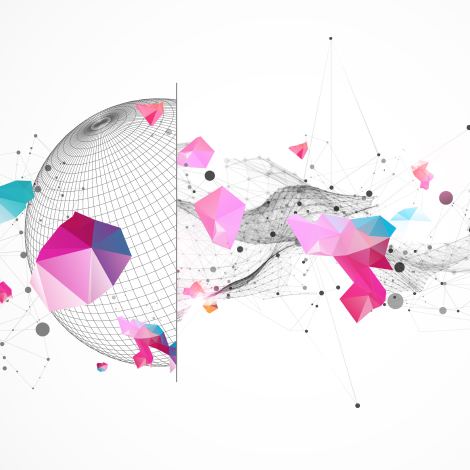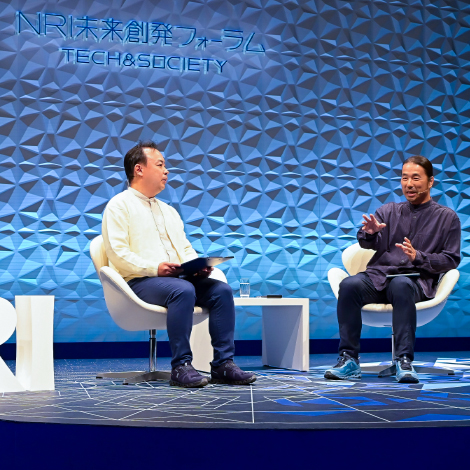Prospects for a New Society in the Generative AI Era – NRI Dream Up the Future Forum: Tech & Society (Part 1)
#AI
#DX
#Management
Jan. 30, 2024
The “NRI Dream Up the Future Forum: Tech & Society” was held online on October 30, 2023. Organized around the theme of “New Society in the Generative AI Era”, the forum played host to lectures from the expert perspectives of three NRI Center for Strategic Management and Innovation members who have spent years researching the relationship between AI and society, providing a venue for discussion of the relationship between humans and AI in the generative AI era, and of the challenges and prospects for a new society in which AI will be a pervasive and constant presence. This article reports on the lectures in Sessions 1-3.
AI and capitalism: Will it bring about a creativity revolution or lead us into servitude?
In Session 1, Takeshi Mori, Director of the Digital Society Research Office of NRI’s Center for Strategic Management and Innovation, took the stage and spoke from his unique perspective on the subject of how capitalism will incorporate generative AI.

The “ChatGPT” generative AI reached approximately 100 million users within three months of its release in November 2022, but this can be understood as a byproduct of Covid-19 vastly expanding the digitalization of everyday life and thus spurring the emergence of generative AI, which learns with ever-greater precision as it has access to more digital data. A good historical parallel is found in the mid-14th century, when the Black Death that spread throughout Europe resulted in a severe labor shortage, which, in turn, sparked the invention of an innovative tool called the printing press, leading to a dramatic rise in book publication.
Mr. Mori noted, “Just as the invention of typographic printing led undeniably to an explosion of information and a creativity revolution in the Renaissance age, generative AI will expand the horizons of ‘space’ and ‘time” and, perhaps more importantly, will also expand the horizons of the ‘heart’ through communication with non-human entities. Generative AI is the fountainhead of a communication and creativity revolution.”
The current Japanese economy is facing a decline in “idea productivity”, in which investment in intellectual property often fails to produce technological progress or enhanced efficiency. According to economic growth theory, economic growth is the product of “changes in labor input”, “changes in capital input”, and “changes in TFP (total factors in productivity), a concept encompassing things like enhanced efficiency and technological progress”, and this can be thought of as meaning that increased efficiency will produce economic growth even if labor input and capital input do not change. For the Japanese economy, where negative labor input is expected going forward and capital input will shrink as well, the question of how to increase TFP is an essential issue.
Mr. Mori predicts that “capitalism will definitely try to utilize the perfectly adapted tool of generative AI to increase idea productivity and TFP and precipitate economic growth.” The concept of idea productivity can be divided into idea flow (increasing the volume of ideas) and idea valuation (linking ideas to values), but it is idea flow that is especially important. Mr. Mori stresses, “Humans and generative AI probably will work together in pursuit of the mass production of ideas and the streamlining of processes.
The economic growth from these efforts will be won or lost through ‘creativity’, to which generative AI holds the key.”
Regarding creativity, in the 1990 publication “Strategies for Creation”, NRI predicted the coming of a “creative society” as a fourth wave building on the information society. In this creative society, “creative enterprises [tentative name]” involved in the mass production of ideas would appear on the scene to drive the industrialization of creative power and the accumulation of knowledge capital.
Three images of the future are conceivable for the creative society, based on differences between the entities doing the creating. In Scenario 1, “Eudaemonia”, generative AI acts as a daemon (spirit from ancient Greek mythology), i.e., good assistant, and human beings exercise creativity. In Scenario 2, “Idea Consumption”, ideas are created by a minority of humans and consumed by a large majority of humans. In Scenario 3, “Idea Automation”, generative AI automatically generates ideas and humans are de facto slaves. Mr. Mori noted, “Needless to say, Scenario 1, where generative AI acts as a eudaemon to improve human wellbeing while simultaneously pursuing economic growth, is the best image of the future.” He then brought his session to a close by observing, “Japan has the potential to utilize generative AI to drive the creative society worldwide. The image of the future we create will depend on our choices and our actions.”

Expanding Societies: Designs for Human-AI Cooperation
In Session 2, Takeo Nishikata, an Expert Researcher in the Digital Society Design Research Department of NRI’s Center for Strategic Management & Innovation, spoke on the topic of human-AI cooperation.

What impact will AI have on societal systems such as nations, corporations, and social networking services? In the next 10 years, predictive and analytical AI will spread rapidly and be utilized in various fields, and progress in generative AI will bring AI answers to a level that cannot be distinguished from humans. Mr. Nishikata observed, “Generative AI is just one checkpoint, and future AI advances most likely will take many forms. In modern civilization, social systems were built on the assumption that human beings had the most advanced intelligence, but today, it may be the case that both humans and AI have intelligence, and so we are faced with the question of what social systems should be built going forward.”
In a multipolar world, the future of social systems will not take one uniform shape, and the expectation is that there will be a multidimensional future defined by differences specific to societies and cultures. Two major orientations – namely, the “mechanical society” and the “biological society” – are conceivable in such a multidimensional future.
“Mechanical social systems”, which are like the current social system, are based on the ideas of (i) decision-making by “rational individuals”, (ii) “optimization” to continually maximize predetermined targets, and (iii) “governance” that manages according to laws, rules, etc. However, as can be seen in the fact that GDP maximization creates environmental problems and social media attention maximization produces societal fragmentation, the balance between economic value and social value is a tenuous one.
In contrast, “biological social systems”, where ideas originate from biology, are based on the ideas of (i) “search and learn”, where decisions are made by learning from surroundings, (ii) “adaptation” to respond flexibly to environmental changes, and (iii) “cooperation” to solve social problems autonomously. Here, a balance between economic value and social value can be expected.
Mr. Nishikata prefaced his remarks by saying, “When we think about the techniques by which AI will expand the capabilities of social systems, there are two major paths: expanding the ‘mechanical society’ and expanding the ‘biological society’.” He then elaborated, “Our current society is in an unbalanced state with very strong mechanical overtones, and if AI is used to expand the ‘mechanical society’, these problems will deepen further, and we will risk turning into an AI-centric society. If, on the other hand, the ‘biological society’ is brought into the mix and AI is used to expand it, the balance of economic value and social value will be facilitated, and we can expect a society centered on humans and the environment. As we move toward 2030, it seems to me that we should be using AI to expand the ‘biological society’ and ensure a balance between economic and social value.”
Looking even farther into the future, Mr. Nishikata made an appeal: “The history of AI and artificial life has emerged from repetitions of a cycle in which ‘biology’ such as brains and nerves was studied to create models of intelligence and life, and ‘machines’ created based on these were studied to update the models. It seems desirable for social systems to be built according to a cycle that will learn in a well-balanced manner from both the ‘biological society’ and the ‘mechanical society’, thus ensuring the sustained improvement of both economic and social value.”

The Evolution of Knowledge: Generative AI and Productivity in the Year 2030
In Session 3, Yoshiaki Nagaya, an Expert Strategist in the Digital Society Design Research Department of NRI’s Center for Strategic Management & Innovation, took the stage to discuss effects on productivity enhancement and challenges and prospects for an AI-inclusive society, with a focus on generative AI “knowledge.”

Up to now, AI research and debate has focused on skills, and the perspective that knowledge is a thing possessed by humans has failed to imagine knowledge acquisition by AI. Knowledge and skills are related in that knowledge is a precondition for skill acquisition and plays the role of making skills more effective. In generative AI, each individual model consists of two logical strata – namely, systems, which correspond to skills, and data, which corresponds to knowledge.
Mr. Nagaya explained, “With regard to skills, things have emerged which approach and threaten human capability in areas like writing, translation, and programming, but with regard to knowledge, the capabilities are unevenly distributed, and technology is still developing.” Regarding the future of generative AI, he predicts, “Along the axes of purposes assigned by humans, information will accumulate in a manner akin to short-term memory, and this information will be generalized and acquired as new knowledge. Furthermore, linkages between multiple generative AIs will work to create more sophisticated generative AI. The linked generative AIs will internally differentiate between knowledge areas and system areas, evolving into networked confederations of little AIs, and these AIs will exchange language with each other as a common set of specifications, thus becoming truly human-like systems.” It may be that, when the internal networks of generative AI have developed to an advanced degree, the formation of virtual groups, companies, and societies would no longer be about the world of science fiction.
But what will happen when generative AI beings to talk to its internal other? Mr. Nagaya suggested, “Generative AI has individuality, and it will need to cooperate and interact well with others to solve problems efficiently. Just as cooperation engenders shared concepts of morality and culture in human societies, the virtual societies formed within AI may allow AI to attain cooperativeness, culture, and even morality through trial and error.”
The “GPT-4” language-trained generative AI can understand errors and textual meaning from the arrangement of text. The “AlphaMissense” generative AI, which was trained on protein sequences using the same technology, uses such sequences to predict whether proteins are normal or pathogenic. Mr. Nagaya views this as “a harbinger of generative AI’s acquisition of innovative knowhow and ingenuity. Up to now, the human acquisition of knowledge has been dependent on genius and felicitous accidents, but generative AI may discover rules on its own, continuously, which would have been totally inconceivable to humans on our own.”
Looking ahead, what will happen to human work as AI supplants human skills and begins to weave new knowledge into being? One possibility is that human-AI cooperation will take hold, giving birth to organizations run by human managers and multiple AIs. The skill-dominant society will have transformed into a management-dominant society.
Nagaya’s prediction is that “we are moving from an era of specialists to an era of ‘new generalists’ who manage AI.” He stresses, “From cooperation with AI, we will gain experience, search for expertise based on those insights, and thereby increase knowledge. AI will lower the barriers between professions, and superior expertise will come not from without (environmental change), but from within (inquisitive spirit).”

Presenter Profiles
Session 1: Takeshi Mori – Director of the Digital Society Design Research Department of NRI’s Center for Strategic Management and Innovation.
After stints as a researcher and consultant, he was engaged in senior executive training at the Nomura School of Advanced Management, joining NRI’s Center for Strategic Management and Innovation in 2019. He is involved in a multifaceted range of research and informational activities on digital technology’s impact on economy and society, and is the co-author of “Digital Capitalism” (Okawa Publications Prize, 2019), “Digital Wealth of Nations”, and “Digital Appreciation Revolution”.
Session 2: Takeo Nishikata – Expert Researcher in the Digital Society Design Research Department of NRI’s Center for Strategic Management & Innovation.
Originally an engineer, he is engaged in technical R&D and international standardization. His recent research has focused on the design of digital society infrastructures based on the environmental changes produced by cutting-edge technology. Appointments include Visiting Researcher at the MIT Sociotechnical Systems Research Center, Member of the MIT Council on Extended Intelligence, and Convenor of a Study Group of the ISO/TC 307 Technical Committee on distributed ledger technologies. He is also the co-author of “Trusted Data”.
Session 3: Yoshiaki Nagaya – Expert Strategist in the Digital Society Design Research Department of NRI’s Center for Strategic Management & Innovation.
He has been engaged for approximately 10 years as an IT analyst in studying technical trends and early/portentous case studies in AI and formulating strategies for client companies, with his focus recently expanding into study and research on the social impact of AI’s evolution. He is the co-author of “AI Complete Guide”, “Complete Guide to ChatGPT and Generative AI”, and other publications.







